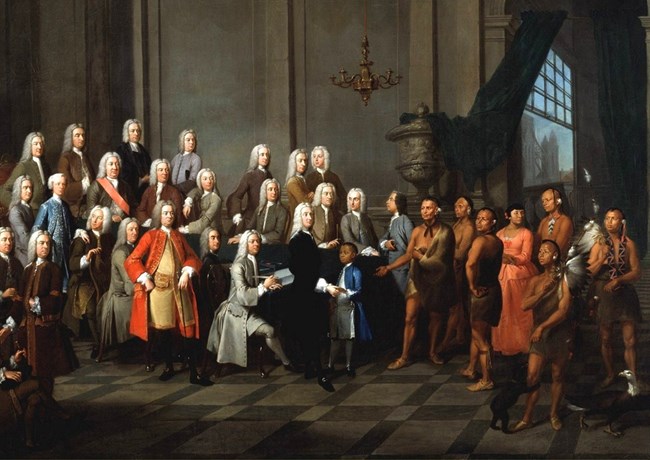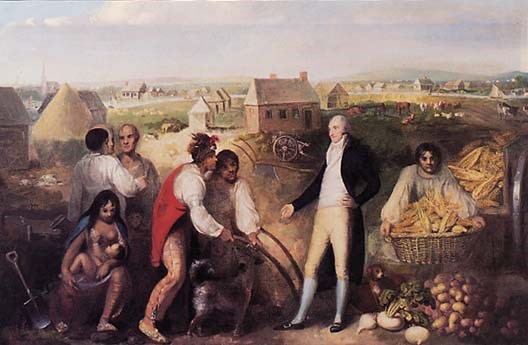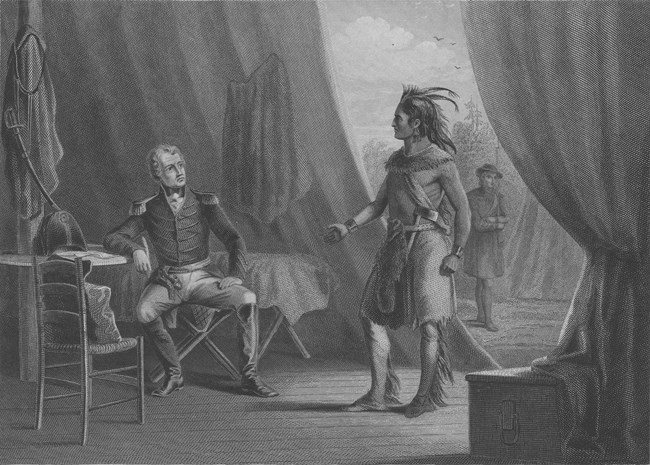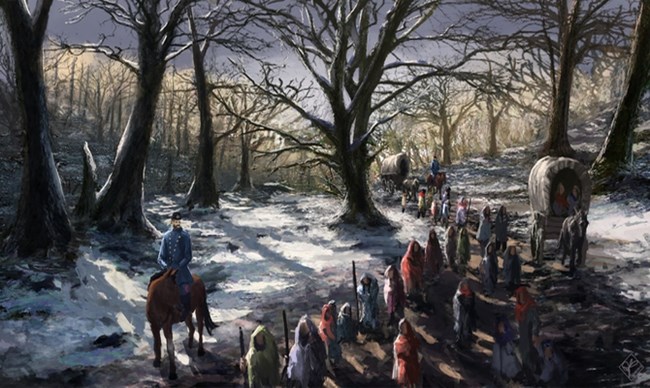|
The Muscogee people - called "Creek" by British settlers - are direct descedents of the great mound builders of what are today the southeastern states of Alabama, Georgia, Florida, and South Carolina. As the culture of their ancestors dissolved in the wake of and new diseases and chaos brought on by the Spanish conquistadors, groups of survivors spread out and formed their own tribes. The Muscogee were comprised of not just a single tribe, but a union of several, forming the Muscogee confederacy. Individual tribal towns shared common cultural traits while maintaining their own individual political power. Growth of the confederacy was a combination of population growth, conquering and absorbing other tribes, and taking in refugees from tribes destroyed by European encroachment. 
The Lower Creek tribes were closer to the English settlments, and thus greatly influenced by English culture, technologies, and ways of thought. The Upper Creek tribes, through the benefit of distance from Europeans, were able to maintain more traditional ways of life. Neither distance nor familiarity with the Europeans and Americans would save the Muscogee from losing their lands and traditional ways of life. 
A 19 year period of peace between the Muskogee people and the American government led to the ceding of Lower Creek lands in eastern Georgia to the United States, a federal road leading from New Orleans to Washington, D.C., and the adoption and success of cotton plantations, businesses, and slavery among the Muskogee. The construction of Fort Benjamin Hawkins (in modern day Macon, Georgia) served the dual purpose of protecting the Muscogee from the expansion of settlers, while also acting as a reminder to the Muscogee of U.S. rule.
A rise in the desire to return to traditional ways across the American frontier with Native American lands set into motion a permanent change to the Muscogee confederacy. Tired of broken treaties and the loss of sacred lands and traditional beliefs, the Shawnee leader Tecumseh began forming a confederacy of his own with the goal of putting aside tribal and cultural differences and putting up a united front against American, English, and French encroachment. Tecumseh, along with his healer/religious prophet brother Lalawethika (later to be called Tenskawatawa), told various tribes that the willful sale/cessation of land and the turning of their backs on traditional ways had angered their gods. In March of 1811, before a visit by Tecumseh to Tuckabatchee (one of the four Muscogee mother towns), a comet appeared. Tecumseh, whose name means "Shooting Star", told the Muscogee that the comet signaled his coming, that he was sent by the Great Sprit, and that the Muscogee would be given a sign. After Tecumseh left, the sign appeared in the form of an earthquake. This earthquake helped convince the Muscogee and other tribes that Tecumseh's cause was to be supported. 
The Red Sticks success at battles such as the Battle of Burnt Corn, the Fort Mims Massacre, and the Kimbell-James Massacre caused panic throughout the southeastern United States. Federal soldiers were committed to fighting the British and unavailable to face this new southern threat. Tennessee, Georgia, and Mississippi sent out the call to raise a militia, Joining with Lower Creek Muscogee and Cherokee warriors, General Andrew Jackson's Tennessee militia fought and pursued the Red Sticks through eastern Alabama, culminating in the Battle of Horseshoe Bend (March 27, 1814) and the defeat of the Red Sticks. Remnants of the Red Sticks continued to fight through August, but ultimately surrendered on August 9, 1814, The history and stories of the Red Sticks, the Lower Creek Muscogee, the Cherokee, and the American soldiers are preserved to this day for visitors at Horseshoe Bend National Military Park, two hours south of Little River Canyon National Preserve. The Muscogee on both sides of the conflict ultimately paid the price in losing 20 million acres of their ancestral lands - the Red Sticks because of their hostility against the United States, and the Lower Creek Muscogee because, according to General Andrew Jackson, they allowed the Red Sticks to revolt. The lands surrendered by the Red Sticks largely makes up the state of Alabama, which was admitted to the union in 1819. Many of the Upper Creek Muscogee refused to surrender and escaped into Spanish Florida, where they allied themselves with other remnant tribes forming the Seminole tribe. 
When Andrew Jackson was elected president in 1829, U.S. policy towards Native Americans would change rapidly. No longer would different Native American tribes be treated as separate nations, they were seen all as one, and his plan was to move all tribes east of the Mississippi River to Oklahoma. The Indian Removal Act was signed into law on June 30, 1830. In 1832, the Creek National Council signed the Treaty of Cusseta, ceding the remainder of their lands east of the Mississippi to the U.S. and accepted relocation to Oklahoma. While some Muscogee left Alabama early, the majority were removed during the Trail of Tears in 1834. Learn about the Trail of Tears online or in-person by visiting the Trail of Tears National Historic Trail. |
Last updated: May 24, 2021
